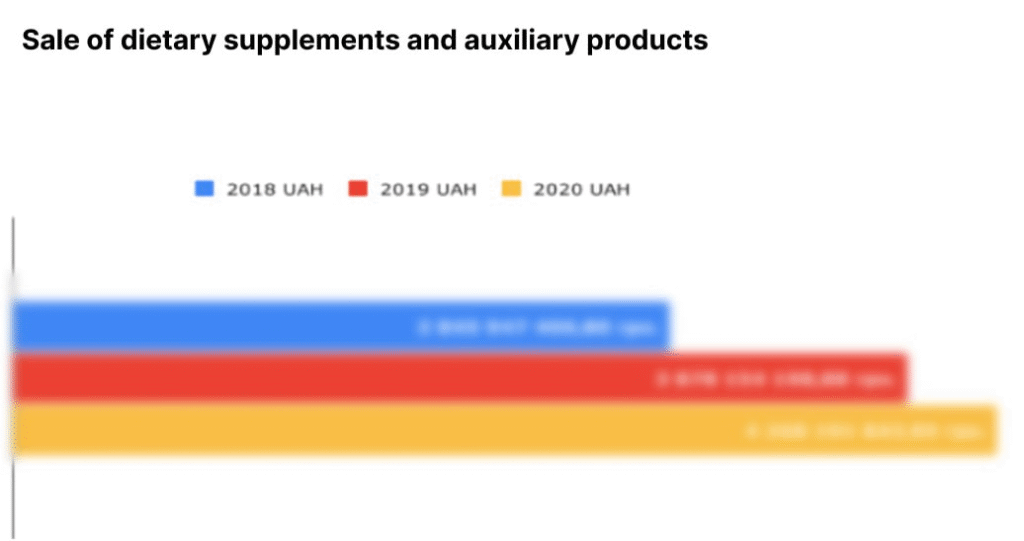The beauty market is a battlefield — crowded with established giants all vying for consumer attention.
Competition is fierce, and global brands already hold strong positions.So how can a new player not just enter the space, but become the first choice for customers?
Our client — leading distributor of premium brands in the field of aesthetic medicine — operating since 2010.
They deeply understood the market and recognized a fast-growing demand for nutricosmetics.
Their answer? Launch a new brand designed to meet the high-quality expectations of today’s beauty-conscious consumers.
But the big question remained:
“How can a new brand gain a foothold — and become the go-to choice in the nutricosmetics category?”
Our Mission: build a full-funnel marketing strategy that would:
- Boost brand awareness and build a strong association:
When it comes to nutricosmetics — this is the brand. - Achieve consistent revenue goals:
€150,000 / month and €1,500,000 / year - Attract new customers in the B2C segment
| How much time did the strategy development take? | 150 hours of focused work, 6 working weeks |
| Who was on the marketing strategy development team? | Head of Marketing Team, Head of PM Team, Head of Content Team, Project Manager, Operational Marketer, SMM Marketer, Head of PPC Department, PPC Facebook Specialist. |
| How was the result of the work used? | Implemented independently by the client’s internal specialists |
We signed a Non-Disclosure Agreement (NDA), so in this case study, the client will remain anonymous.
Project Topic
Our client was already one of the leading and most trusted distributors in the field of aesthetic medicine, but they were new to the nutricosmetics segment.
💡 Nutricosmetics are biologically active supplements in the form of capsules, tablets, powders, or liquids that work from within to improve the condition of the skin, hair, and nails, complementing traditional cosmetic care.
The brand had a wide range of products. The main product lines included:
- for healthy, glowing skin;
- for strengthening hair;
- longevity-focused supplements.
The main challenge was to showcase the product’s uniqueness in a market filled with long-established competitors and loyal customer bases.
Goals and our first steps
Our mission was clear: help the brand become recognizable, build trust in the product, and ensure a steady flow of sales.
But first, we needed to answer several key questions:
● What is the brand’s current position in the competitive landscape?
● How do customers make purchasing decisions?
● Which promotion channels will have the greatest impact for the company?
The answers to these questions became the starting point for building the marketing strategy.
To understand the current state of the market and the brand’s opportunities, we began with deep analysis.
How we researched the market and audience
To develop an effective marketing strategy for the client, our approach included several key steps:
Market trend research
We analysed general trends in the nutricosmetics industry using industry research data, Google Trends analytics, and consumer preference reports.
This helped us understand that the market is growing rapidly, and nutricosmetics are becoming increasingly popular.
Our analysis included:
- Studying search query trends for key terms.
- Analyzing seasonality of demand for nutricosmetics.
- Tracking growing interest across different product categories.
What did we discover?
The nutricosmetics market was gaining momentum at an incredible pace, and consumers were becoming more educated about ingredients and their effects.
Sales dynamics of dietary supplements

Competitor research
First, we conducted an analysis of the main market players, which included:
- A detailed study of their websites and usability.
- An analysis of their product range and pricing strategy.
- Research into their marketing activities and communication channels.
- An evaluation of their social media strategies.
We compiled all the information into a detailed market map and, most importantly, identified the gaps that our client’s brand could potentially fill:
Competitor analysis

And here we noticed an interesting pattern: most competitors focused on scientific research and innovation, but almost none offered a personalized approach to the customer. This became a key argument on which the brand could build its uniqueness.
Target audience profiling
At the briefing stage, the client already had a general idea of their target audience, but we significantly deepened this understanding to allow for more precise communication strategies. Based on the analysis of competitors’ customers and sociological data, we created detailed profiles of potential buyers:
— Women and men aged 25–44 who care about their health and appearance.
— People who lead an active lifestyle, engage in sports, and follow healthy eating habits.
— Vegans and keto-diet supporters who value product naturalness.
📌 Already thinking about entering the B2C market? Book a consultation and we’ll help you evaluate your brand’s potential!
Are you thinking of entering the B2C market? Sign up for a consultation and we will help you assess your prospects!
How we built the strategy: from idea to implementation
For us, developing a marketing strategy is a comprehensive process. Each stage contributes to building a complete picture for creating expert insights and testable hypotheses that deliver long-term results.
After conducting market and competitor analysis, we move on to the following stages:
Stage 1: Website and communication optimization
The challenge we identified:
When analyzing our client’s website, we noticed it resembled a beautiful showcase — one that few people actually saw. The site wasn’t optimized for organic traffic, and the few visitors who did land on it didn’t stay or make purchases. Why? It lacked persuasive content and social proof to build trust.
Some of our recommendations for improving the website included:
| Website structure overhaul to enhance user experience |
1. Reorganizing menu and product categories. 2. Optimizing page load speed. 3. Developing a responsive design for mobile devices. |
| Integration of a customer reviews section |
1. Collecting and structuring reviews. 2. Developing a verification system for real users. 3. Creating a UX design that builds trust. |
| Product page optimization focused on conversion |
1. Structuring product information from most important to details. 2. Adding clear calls to action (CTAs). 3. Adding comparison tables with competitors. |
| Development of an SEO-optimized blog with valuable content |
1. Creating a content plan based on search queries. 2. Developing article structures for maximum engagement. 3. Planning a consistent publishing schedule. |
📌 Make sure your business is performing at its best! Book a consultation with a marketing expert and receive tailored recommendations to boost your company’s marketing effectiveness.
Stage 2: Content strategy and social media
The challenge we identified: the audience had limited awareness of the brand, and traditional advertising tools failed to build trust. It was necessary to create a strong informational foundation for promotion.
Even at the stage of market and competitor analysis, we noted several important aspects with strong potential. For example:
| Website structure redesign to enhance user experience |
1. Reorganizing the menu and product categories. 2. Optimizing page load speed. 3. Developing a responsive design for mobile devices. |
| Integration of a customer reviews section |
1. Collecting and structuring customer feedback. 2. Building a real-user verification system. 3. Creating UX design to foster trust. |
| Product page optimization with a focus on conversion |
1. Structuring product information from key details to specifics. 2. Adding clear calls to action (CTAs). 3. Including comparison tables with competitors. |
| Creating an SEO-optimized blog with valuable content |
1. Developing a content plan based on search queries. 2. Structuring articles to maximize engagement. 3. Planning a regular publication schedule. |
Stage 3. Launching advertising campaigns
The challenge we discovered: even the best product doesn’t sell itself. We needed to find channels to engage the target audience that would work best for the brand.
To test the most effective promotion channels, we added multi-channel advertising campaigns to the strategy:
| Google Ads |
1. Search campaign structure using different keyword match types. 2. Remarketing strategy to re-engage past visitors. 3. Media plan with projected budget and KPIs. |
| Meta Ads |
1. Detailed media plan with campaign types and target audiences. 2. Creative strategy tailored to different ad formats. 3. Performance tracking and optimization system. |
| Email Marketing |
1. Automated email sequences for different audience segments. 2. Content personalization strategy. 3. Calendar of regular mailings with engaging and useful content. |
Our marketing strategy brought all these elements together into a cohesive system that works both to attract new customers and retain existing ones, ensuring a steady client flow and continuous growth in brand awareness.
Conclusions
In just 4 weeks, we:
✓ Conducted a comprehensive market and competitor analysis, including a review of their marketing strategies, websites, and communication channels.
✓ Identified effective promotion channels based on target audience behavior data.
✓ Developed a step-by-step marketing strategy with clear implementation actions.
✓ Provided detailed website optimization recommendations to increase conversions.
✓ Prepared a launch plan for advertising campaigns with forecasted performance metrics.
Although our client had strong expertise in the beauty industry, launching a new brand is always a challenge and a test of the market. Even if you’re a guru in your field, a local niche can have completely different rules, a unique competitive landscape, and distinct consumer habits.
That’s why a marketing strategy is an essential tool that provides a realistic picture of the market. As a result, the brand receives a personalized development and scaling plan built on a holistic approach — from analytics to selecting the most effective marketing tools.
Key takeaways from the project:
- For niche products like nutricosmetics, a comprehensive marketing approach is the most effective. Success is impossible to achieve through a single promotion channel alone.
- A successful strategy is always preceded by in-depth research of the market and audience. Even if a client already understands their target audience, deeper analysis always uncovers new targeting opportunities.
- In highly competitive niches, trust in the brand becomes a critical success factor. Developing a strategy focused on building trust through educational content, social proof, and expert opinions ensures a long-term advantage.
- A marketing strategy for cosmetics and nutricosmetics brands must be flexible and adaptive in order to quickly respond to changes in consumer behavior and market trends.
Growing your business in the beauty industry? We’ll craft an effective strategy for you!
✔ We’ll assess the market — identifying growth potential and key opportunities.
✔ We’ll analyze your website — uncovering ways to improve conversion.
✔ We’ll develop a personalized growth strategy — adapted specifically to your brand.
🚀 Ready to scale?
FAQ: common questions about promotion strategy in the beauty industry
❓ How can nutricosmetics be promoted in a highly competitive market?
✅ Our research shows that the most effective method is a comprehensive approach that includes educational content, collaboration with opinion leaders, and targeted advertising. The key factor is building trust in the brand through expert content and social proof.
❓ How do you run ads for nutricosmetics if they often get blocked on Meta?
✅ In our strategies, we recommend using soft language, focusing on general health and beauty topics rather than medical claims. It’s also important to diversify ad accounts and consistently test different creative approaches.
❓ Which marketing channels work best for nutricosmetics?
✅ According to our findings, the most effective channels include: SEO focused on informational search queries,
Content marketing (expert articles, product video reviews),
Targeted ads on Meta and Google, Collaborations with relevant influencers, Personalized email marketing.
❓ How long does it take for SEO promotion to show results?
✅ Initial results typically appear within 4–6 months of active work on content and technical optimization. Consistent organic traffic growth usually begins after 6–12 months of ongoing SEO strategy. It’s important to treat SEO as a long-term investment in your brand’s marketing.




